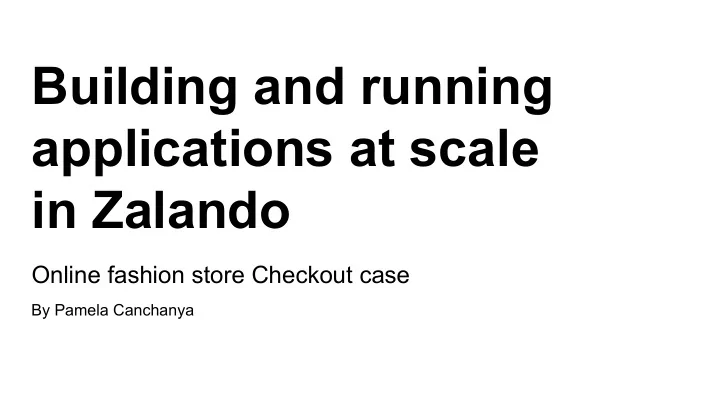

Building and running applications at scale in Zalando Online fashion store Checkout case By Pamela Canchanya
About Zalando
About Zalando > 250 visits ~ 5.4 billion EUR per million month revenue 2018 > 300.000 > 26 product choices > 15.500 > 70% 17 million ~ 2.000 employees in of visits via countries brands Europe active customers mobile devices
Black Friday at a glance
Zalando Tech
From monolith to microservice architecture Reorganization > 1000 microservices
Tech organization > 200 > 1100 development developers teams Platform
End to end responsibility
Checkout Goal “Allow customers to buy seamlessly and conveniently”
Checkout landscape REST & messaging Java Scala Communication Node JS React AWS programming languages client side & ETCD Cassandra Docker Kubernetes Many data storage more configurations container infrastructure
Checkout architecture Dependencies Tailor Backend for Cassandra frontend Frontend Checkout fragments service Dependencies Dependencies Skipper
Checkout is a critical component in the shopping journey - Direct impact in business revenue - Direct impact in customer experience
Checkout challenges in a microservice ecosystem - Increase points of failures - Multiple dependencies evolving independently
Lessons learnt building Checkout with - Reliability patterns - Scalability - Monitoring
Building microservices with reliability patterns
Checkout confirmation page Delivery Destination Delivery Service Payments Service Cart
Checkout confirmation page Delivery Service
Unwanted error
Doing retries for (var i = 1; i < numRetries; i++) { try { return getDeliveryOptionsForCheckout(cart) } catch(error) { if (i >= numRetries) { throw error; } } }
Retry for transient errors like a network error or service overload
Retries for some errors try { getDeliveryOptionsForCheckout(cart) match { case Success() => // return result case TransientFailure => // retry operation case Error => // throw error } } catch { println("Delivery options exception") }
Retries with exponential backoff Attempt 3 Attempt 1 Attempt 2 100 ms 100 ms 100 ms Exponential Exponential Backoff time Backoff time
Exhaustion of retries and failures become permanent
Prevent execution of operations that are likely to fail
Circuit breaker pattern Circuit breaker pattern - Martin Fowler blog post
Open circuit, operations fails immediately error rate > threshold 50% Target getDeliveryOptionsForCheckout = failure
Fallback as alternative of failure Fallback: Only Standard delivery Unwanted failure: no Checkout service with a default delivery promise
Putting all together Do retries of operations with exponential backoff Wrap operations with a circuit breaker Handle failures with fallbacks when possible Otherwise make sure to handle the exceptions circuitCommand( getDeloveryOptionsForCheckout(cart) .retry(2) ) .onSuccess(//do something with result) .onError(getDeloveryOptionsForCheckoutFallback)
Scaling microservices
Traffic pattern
Traffic pattern
Microservice infrastructure Incoming requests Load balancer Distributed Use Zalando Instance Instance Instance by instance base image Container Node env JVM env
Scaling horizontally Load balancer Instance Instance Instance Container
Scaling horizontally Load balancer Instance Instance Instance Instance Container
Scaling vertically Load balancer Instance Instance Instance Container
Scaling vertically Load balancer Instance Instance Instance Container
Scaling consequences Cassandra > service connections > saturation and risk of unhealthy database
Microservices cannot be scalable if downstream microservices cannot scale
Low traffic rollouts 1 2 1 2 3 4 3 4 Service v2 Service v1 Traffic 0% Traffic 100%
High traffic rollouts 1 2 3 1 2 3 4 4 5 6 Service v2 Service v1 Traffic 0% Traffic 100%
Rollout with not enough capacity
Rollouts should consider allocate same capacity like version with 100% traffic
Monitor microservices
Monitoring microservice ecosystem Microservice Application platform Communication Hardware Four layer model of microservice ecosystem
Monitoring microservice ecosystem Microservice Application platform Infrastructure metrics Communication Hardware For layer model of microservice ecosystem
Monitoring microservice ecosystem Microservice Microservice metrics Application platform Communication Hardware For layer model of microservice ecosystem
First example
Hardware metrics
Communication metrics
Rate and responses of API endpoints
Dependencies metrics
Language specific metrics
Second Example
Infrastructure metrics
Node JS metrics
Frontend microservice metrics
Anti pattern: Dashboard usage for outage detection
Alerting “ Something is broken, and somebody needs to fix it right now! Or, something might break soon, so somebody should look soon. ” Practical Alerting - Monitoring distributed systems Google SRE Book
Alert Unhealthy instances 1 of 5 No more memory, JVM is misconfigured
Alert Service checkout is returning 4XXs responses above threshold 25% Recent change broke contract of API for unconsidered business rule
Alert No orders in last 5 minutes Downstream dependency is experimenting connectivity issues
Alert Checkout database disk utilization is 80% Saturation of data storage by an increase in traffic
Alerts notify about symptoms
Alerts should be actionable
Incident response Figure Five stages of incident response. Microservices ready to production
Example of postmortem Summary of incident No orders in last 5 minutes 13.05.2019 between 16:00 and 16:45 Impact of customers 2K customers could not complete checkout Impact of business 50K euros loss of order that could be completed Analysis of root cause Why there was no orders? Action items ...
Every incident should have postmortem
Preparing for Black Friday - Business forecast - Load testing of real customer journey - Capacity planning
Checklist for every microservice involved in Black Friday - Is the architecture and dependencies reviewed? - Are the possible point of failures identified and mitigated? - Are reliability patterns implemented? - Are the configurations adjustable without need of deployment? - Do we have scaling strategy? - Is monitoring in place? - Are all alerts actionable? - Is our team prepared for 24x7 incident management?
Situation room
Black Friday pattern of requests > 4,200 orders/m
My summary of learnings - Think outside the happy path and mitigate failures with reliability patterns - Services are scalable proportionally with their dependencies - Monitor the microservice ecosystem
Resources - Service reliability engineering - Production ready micro services - Monitoring and alerting Tool used by Zalando - Taylor - Skipper - Load testing in Zalando - Kubernertes in Zalando
Obrigada Thank you Danke Contact Pamela Canchanya pam.cdm@posteo.net @pamcdm
Building and running applications at scale in Zalando Online fashion store Checkout case By Pamela Canchanya
Recommend
More recommend